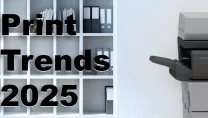For over 50 years, Sharp has been a leader in office technology, starting with analogue copiers in 1972 to today's fully digital multifunction printers (MFPs) that are indispensable productivity tools.
As global trends and the modern workplace evolves, so the requirements for MFPs also change. Sharp is constantly innovating products that meet customer needs not only in terms of technology, but also in ease of use and design. This can be seen in our brand new latest generation of MFPs, such as the Sharp BP-70C65 or Sharp BP-60C45.
Designing new products that not only innovate but also improve efficiency and sustainability takes time and a dedicated team. Many people were involved in the development of Sharp’s latest generation of MFPs, and the product is the result of ingenuity and creativity from a variety of perspectives.
We sat down with Mr Furusawa, Mr Hirano, and Mr Taguchi from Sharp’s development team based in Japan to learn their secrets for creating advanced imaging and green technology and to find out how the latest generation of MFPs improve on what has gone before.
Question: What is the market environment surrounding the digital full-colour MFP business?
Mr. Furusawa: There is a global shift in environmental awareness, as seen in observing Sustainable Development Goals (SDGs), ESG (Environmental, Social, and Governance) perspectives, and circular economy seen especially in Europe. In Japan, there is also a movement toward environmental impact reduction requirements such as green procurement conducted by the Environment Agency.
The world is changing in such a way that more environmentally caring products for daily use are preferred. In addition, office workers are becoming more conscious of the office environment they want to work in and want to work in a more comfortable environment.
Meanwhile, the impact of Covid towards the end of 2019 brought about changes in the way people work. For example, the concept of remote working without coming to the office has become widespread, creating a need for MFPs to support remote work as well. Thus, we are developing products that respond to these changes.
Question: How have you reduced environmental impact?
Mr. Hirano: In recent years, energy conservation has become an important issue due to growing environmental awareness. In response, MFP toner and hardware technology development for energy-saving has been a focus of our company as well.
Question: What kind of toner-related energy-saving technologies have been developed?
Mr. Hirano: The toner fusing process consumes the most power in MFPs. Lowering the fusing temperature is important for energy saving in MFPs. Toner improvement is made to realise toner particle size reduction, optimisation for a new fusing method, and a review of toner material design to achieve both low-temperature fusing and heat-resistant storage stability of toner.
In addition to saving energy by reducing the fusing temperature, the smaller particle size of the toner also plays a role in improving image quality, enabling the printing of clearer images. Improving the toner’s low temperature fixability also means that the toner melts at a lower temperature, so it is necessary to take measures to prevent it from melting during transportation and storage. For this reason, we repeatedly worked with related departments to design toner materials, select additive materials, and consider appropriate evaluation methods, and through trial and error, we were able to establish the current toner formulation and commercialise it.
Question: How about the development of energy-saving technology from the hardware side?
Mr. Taguchi: We have been working to reduce power consumption with toner fixing, which consumes a lot of power, and now we have achieved further reductions by using a pad fixing method, which is a technology that we adopted for the first time.
In the conventional fixing method, heat was transferred indirectly through the heater lamp, heating roller, and fusing belt. The pad fixing method shortens the warm-up time by directly heating the fusing belt with the heater lamp, and by transmitting heat to the paper over a wide area using the fusing pad, it efficiently transfers toner to the paper with a low pressure. This will allow the toner to adhere to the paper.
As a result, we were able to reduce the power consumption of the fusing unit by up to 30% compared to the previous model*, achieving industry-leading low power consumption and a longer fusing belt life that is approximately twice that of the previous model.
At first, it was extremely difficult to apply the new pad fixing method while achieving long life of the fusing belt, which is highly demanded in the market. To improve energy savings, we selected a thin metal-based fusing belt that conducts heat easily and is durable and changed the heat control technology to suit it.
Additionally, if the positional relationship of the fusing belt and pressure roller becomes inconsistent due to variations in parts that occur during manufacturing, the fusing belt will meander from side to side during rotation, which will affect the durability of the fusing belt.
For this reason, we have incorporated measures to extend the life of the fusing belt, including a mechanism and control that automatically corrects meandering. This mechanism and control sometimes caused problems with image quality, but we were able to optimise it by adjusting the shape of the parts, adjusting the mechanism and control, and repeating life aging tests, and ultimately achieved a lifespan that was approximately twice as long as the previous model.
* Comparing power consumption of the fusing unit of MX-2661 and the fusing unit of BP-70C26
Question: How did you respond to changes in work styles?
Mr. Furusawa: The way we work has changed, not only due to the impact of Covid, but also where people in the same department split workplaces such as reporting to the office and working remotely. Now we see more people frequently sharing information via videoconferencing and storing data on cloud servers than before. This has been introduced from previous models, but with this model we enable MFPs to network directly with existing cloud services (such as Google Drive and Dropbox) to make data sharing easier.
In addition, we have made it easy to link our ‘BP series’ with Microsoft Teams, which is being used by an increasing number of users due to the increase in remote work. With the right settings, scanned paper documents can be saved directly from the MFP to a cloud server such as Teams for use in videoconferences, and meeting materials can be printed directly from the MFP without having to be downloaded to a PC.
The MFP connects to the cloud and can also be easily connected to smartphones and mobile devices. Meanwhile, as the number of devices and networks that can be linked is increasing, the level of security requirements is also increasing. Therefore, we have prepared an optional virus detection kit. The MFP will detect any data containing a virus or malware and take measures to protect the office data from spreading to other office equipment connected to it.
Question: The new models have a new colour and badge design – can you tell us about those changes?
Mr. Tsutsui: To express our commitment to care for the environment, we have made two major design changes. The first is the use of a grey colour on the exterior of the MFPs housing to fit in with a variety of office spaces, in response to the shift in the colours required for office spaces from white/black to more subdued, neutral tones.
The second is a renewal of the badge design (leaf badge). Since 2005, our MFPs show a leaf badge as their emblem to express our efforts to reduce environmental impact, such as energy consumption reduction. In recent years, amidst the growing interest in reducing environmental impact, we have changed the design of the leaf badge to express our various environmentally conscious efforts.
Specifically, there were a total of four different badge designs, one for colour, one for monochrome, one for models up to A3 paper and one for up to A4 paper, but in order to further emphasise our environmental consciousness, we unified the badge colour design to a single turquoise blue, and we eliminated the base to create a simple yet impactful design.
In Conclusion
While tech has changed radically since Sharp's first copiers, our commitment to innovation remains strong to this day. As a result, the brand-new Sharp BP Series of colour MFPs continue that legacy - bringing cutting-edge speed, quality and eco-smart design to keep your office running in top gear.
If you would like to know more about the Sharp’s latest generation of colour MFPs, please get in touch.
A version of this article first appeared on our Global Blog.





